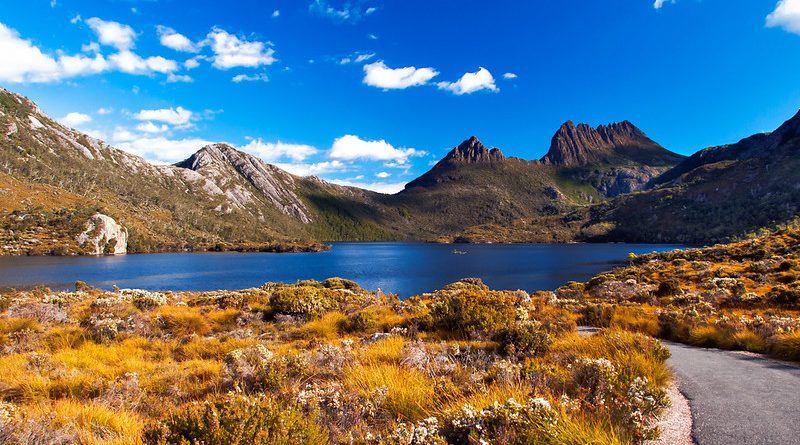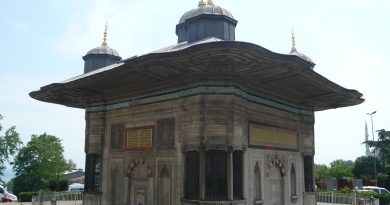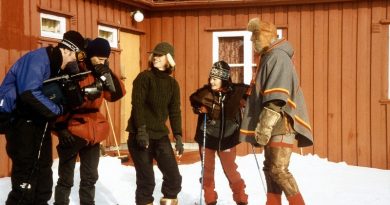Destinations: Tasmania
Hobart
The offshore island state of Tasmania is located at the foot of Victoria in Southeast Australia. Its capital, Hobart, is a city steeped in a colonial history that is still apparent today in its well-preserved Georgian architecture. Looming behind Hobart is Mt Wellington, the summit of which can be reached from the city centre in a full day’s strenuous hike by a fit walker, but which also offers a number of shorter bushwalking trails with spectacular views. Hobart’s vibrant heart is its lively waterfront area, which provides the focus for the end of the annual Sydney to Hobart Yacht Race. Over the New Year period, spectators throng the docks and marinas to cheer the arriving crews, kicking off a 10-day period of festivities, music, and other boat-related events.
Still on the harbourfront, Salamanca Place is a magnificent row of sandstone Georgian warehouses, which date back to Tasmania’s days as a whaling port. These days, the warehouses have been lovingly restored and house delightful restaurants, chic bars, and speciality stores selling a range of arts, crafts and books. Every Saturday, the warm sandstone provides the backdrop for the bustling outdoor Salamanca Market, where a colourful array of local produce, ceramics, glassware, art, flowers and Tasmanian timber-ware are on offer. Buskers and street performers provide entertainment and a wide variety of tempting food is available to recharge the batteries between purchases. If your pockets still need lightening, the towering Wrest Point Casino is an easily identifiable landmark, further along the waterfront. From Salamanca Place,Kelly’s Steps lead to the historic Battery Point, the site of Hobart’s maritime history, where narrow lanes maze between quaint homes and cottages, between which occasional flashes of the harbour can be spotted.
National Parks
Tasmania’s western wilderness is an area of unspoilt natural beauty, which is best experienced in its two World Heritage listed national parks. Hydro-electrical damming plans put the Franklin-Gordon Wild Rivers National Park at the centre of an environmental controversy in the 1980s, but campaigning ensured that today the area still features these two wild rivers thundering through rainforest areas, merging to become the Gordon River. The rush of the river is best experienced with the rush of adrenaline that comes with taking on its elements on a whitewater rafting tour, shooting down Grade 4 rapids through deep gorges with sheer high walls for anywhere up to 14 days. For a less hair-raising brush with this majestic river, a number of short walks are available in the area, as well as scenic flights and cruises in its calmer sections.
Cradle Mountain-Lake St Clair National Park features a spectacularly rugged landscape, carved out by glacial action over thousands of years. Cradle Mountain is reflected in the deep, still, glacial waters of Dove Lake and the area offers countless possibilities for climbing and bushwalking, including the 53 mile Overland Trail, which takes in views of the peaks, rainforest, waterfalls and forests of myrtle, pine, beeches. A riot of wildflowers colours the area in the springtime and brazen wildlife, including Tasmanian Devils (a bush loving marsupial creature the size of a cat) can be seen at close quarters.
East coast
The warm and temperate East Coast of Tasmania is characterised by distinctive blue-green waters tickling the edges of pristine white sandy beaches, towered over by rugged headlands. Nowhere is this more spectacularly captured than at Wineglass Bay, which features a magnificent jagged range of pink granite peaks known as The Hazards. Patched with orange lichen, they rise above the clearest imaginable azure water and an almost ridiculously perfect curve of white sand, which is sheltered on either side by densely forested mountains. TheFreycinet Peninsula is dotted with secluded beaches, including Sleepy Bay with its brightly coloured orange rocks and enjoyable snorkelling and diving, and the Friendly Beaches, which offer literally miles of unspoilt white sand beaches to leave footprints in. Thousands of wildflowers, including over 60 varieties of orchid, grow profusely here and keen birdwatchers will find plenty to keep them occupied. Apart from its outstanding beauty, the whole area is a playground for fishers and boaters, climbers and abseilers, windsurfers and walkers, mountain bikers and swimmers alike. Taking to the waters, cruises to the southern tip of the peninsula offer a different perspective on this most scenic of coasts, plus close encounters with seals, dolphins, whales, penguins and sea eagles.
Tasman Peninsula
The Tasman Peninsula is the home of one of Tasmania’s most visited sites – that of Port Arthur, Australia’s most infamous former prison, a final place of exile for the worst-offending convicts. Today, the prison remains lie in over 40 hectares of landscaped and serene grounds, these surroundings sitting somewhat incongruously with the area’s harsh past. A step back in time can be experienced by exploring any of the 30 buildings and ruins that are still in existence, including a convict-built church, an asylum and a hospital where convicts and soldiers were kept in separate wards. The Isle of the Dead is the settlement’s gloomy burial site, but for a truly hair-raising experience, lantern-led ghost tours take place by night, with a guide telling spine-tingling tales of strange apparitions and unexplained events in the area from the earliest days of convict history to recent times. The whole peninsula is also well known for its sheer, high, weather-sculpted coastal cliffs, seal colonies, waterfalls, secluded bays and scenic vistas.
The Nut
The most striking feature of the rugged North West Coast of Tasmania was called Moo-Nut-Re-Ker by the Tasmanian Aborigines, but is known these days as The Nut. It is an odd-looking geographical outcropping; a table-topped circular headland rising 500ft above the atmospheric and historic town of Stanley nestled at its base. A bracing walk to the top or, for the less energetic, a chairlift, leads to stunning panoramic views over the coast, the Bass Strait and the narrow strip of land linking the Nut back to the mainland. One hour away, the impressive Table Cape is a flat-topped headland of undulating cliffs sloping away into the sea. There are various lookouts along the headland, including one at the base of the historic lighthouse. The nearby town of Wynyard is also a good base from which to explore the Fossil Bluff, site of the discovery of the huge Marsupial Lion – when the tide is out, fossils can be found along the shore at the base of the bluff.
Lake Country
Tasmania’s Lake Country features literally hundreds of lakes, ranging in size from minuscule to massive. The area’s main draw, aside from the serene beauty of these clear, glacial bodies of water and the steep mountains that tower over them, is fishing. The lakes are absolutely stuffed with trout, although strict fishing regulations are aimed at ensuring that it remains this way for the future. The region also comprises rolling farmlands, historic towns, Georgian architecture and sandstone cottages, while the number of antique stores villages peppered through the towns will charm antique enthusiasts. The Ross Bridge is a convict built structure, uniquely decorated with intricate carvings and is worth seeing, especially by night when floodlighting enhances its detailed designs.
Article By Sarah Rodrigues




